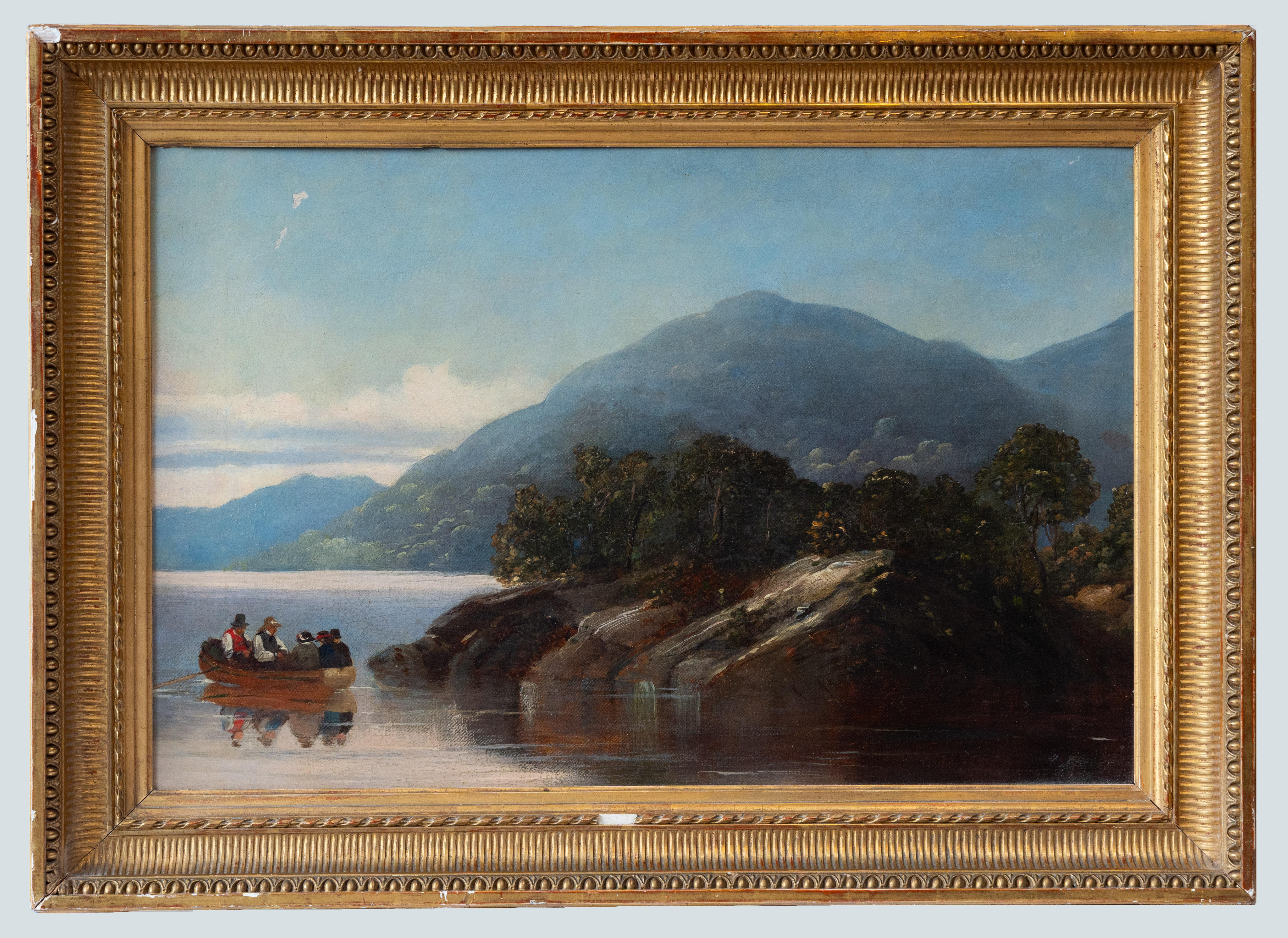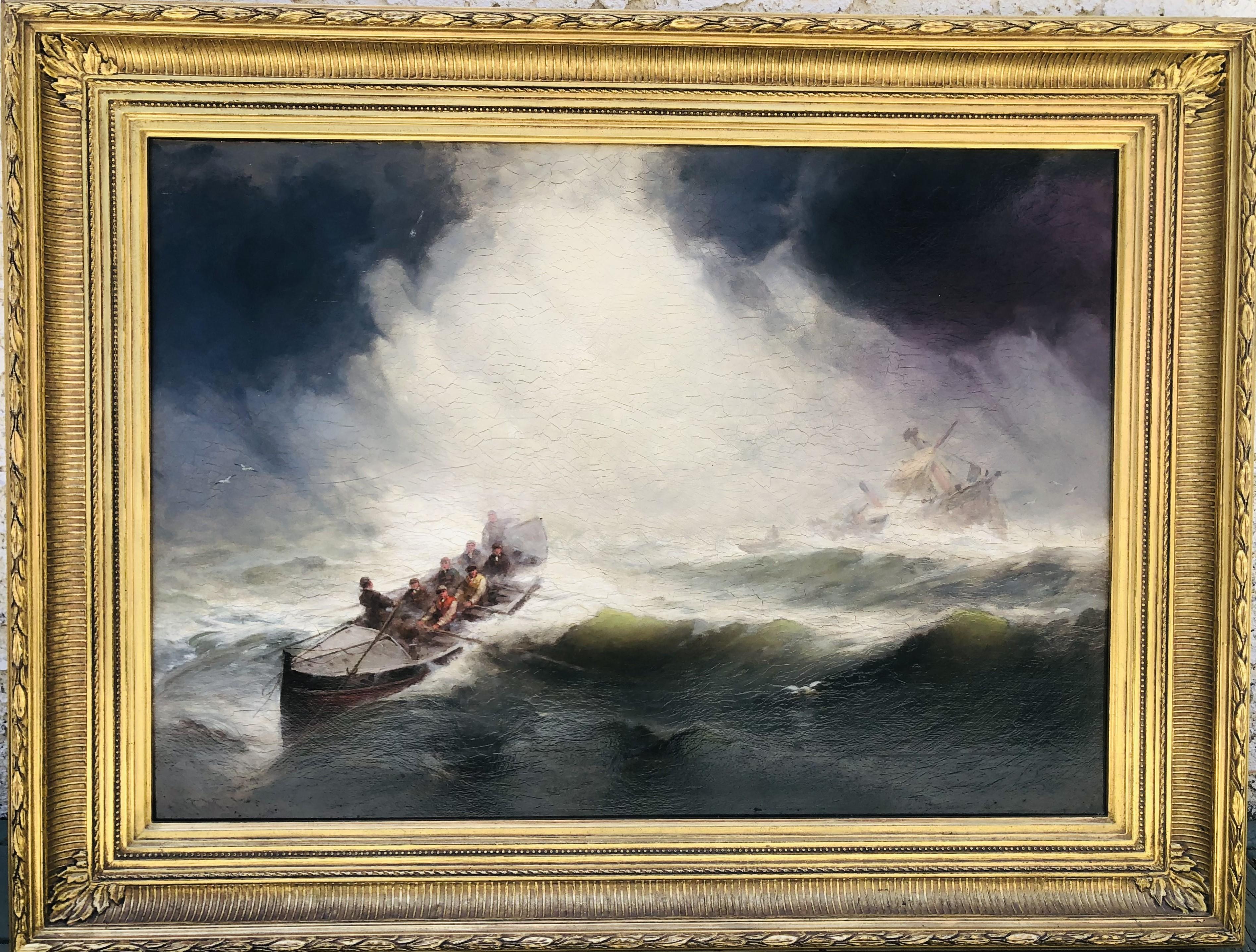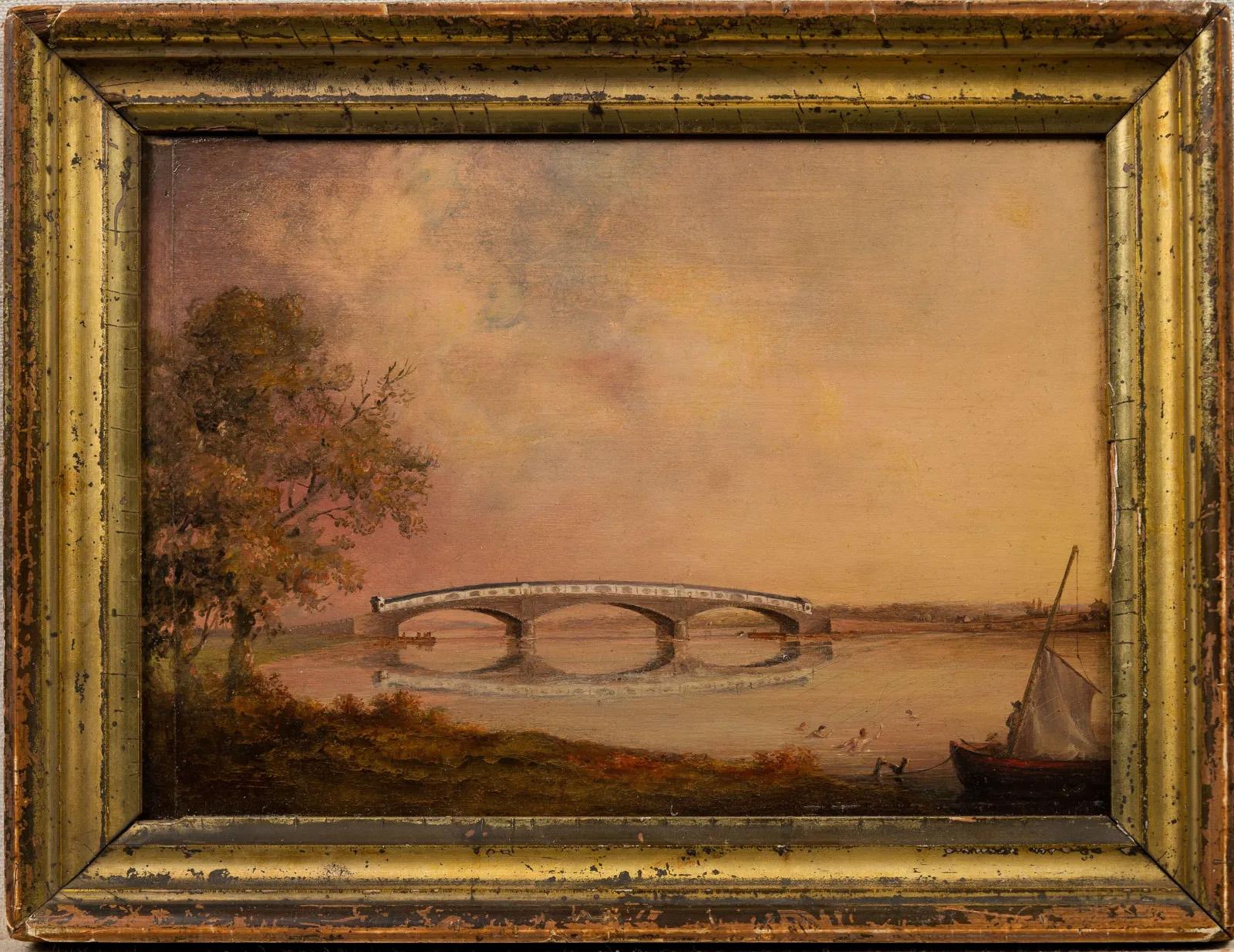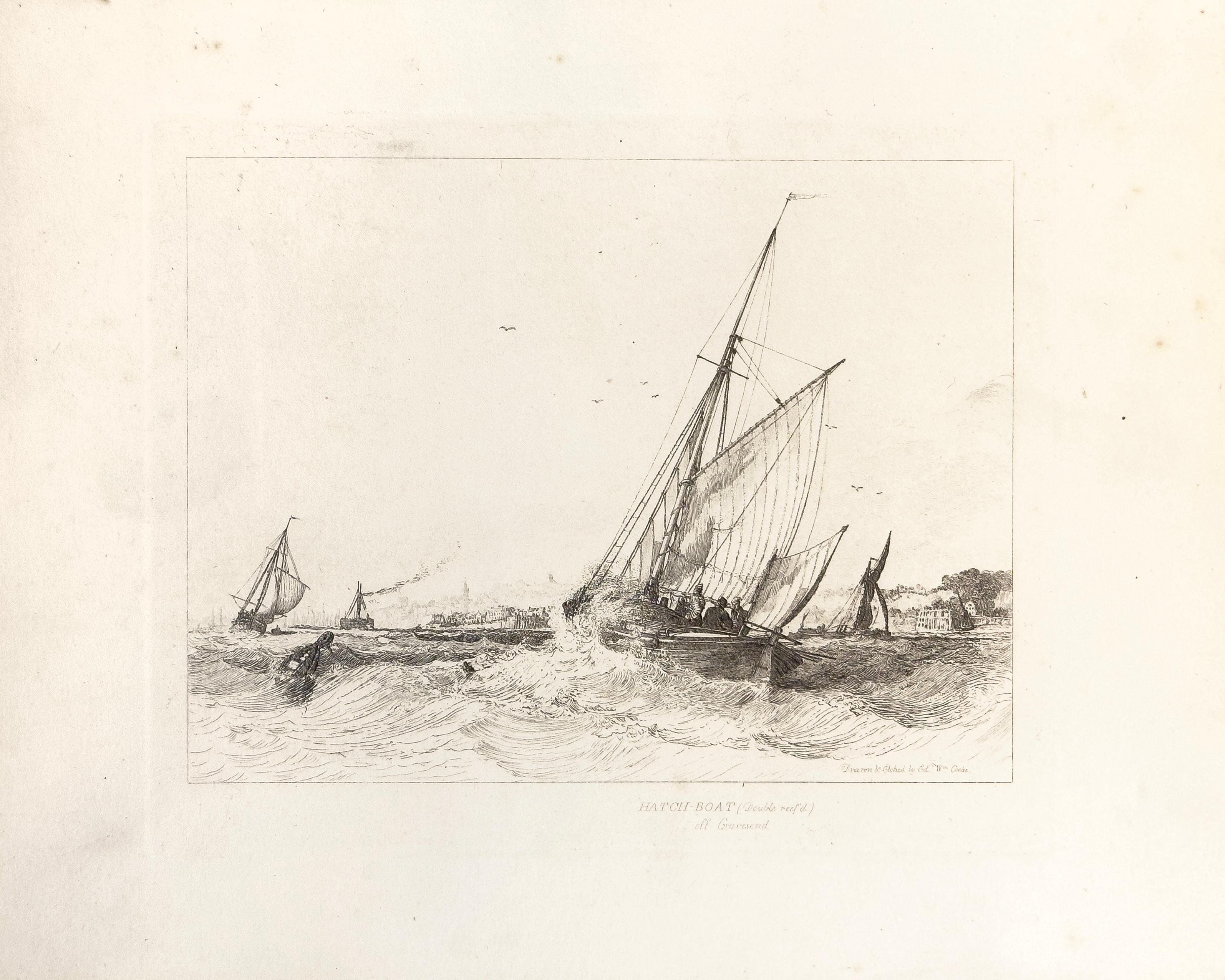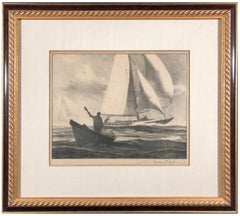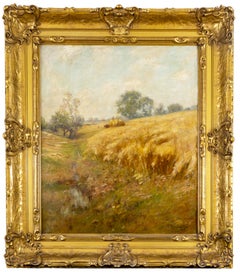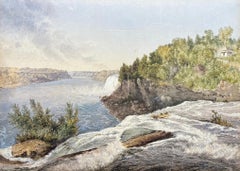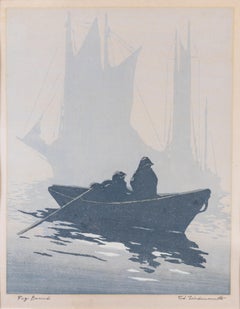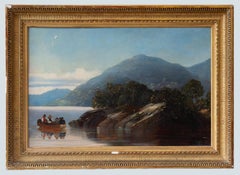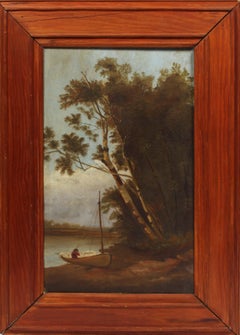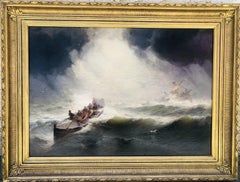Items Similar to The Jolly Flat Boat Men
Video Loading
Want more images or videos?
Request additional images or videos from the seller
1 of 12
The Jolly Flat Boat Men1847
1847
$8,000
£6,200.60
€7,020.56
CA$11,451.34
A$12,486.61
CHF 6,489.90
MX$149,481.41
NOK 82,318.08
SEK 77,106.29
DKK 52,434.53
About the Item
The Jolly Flat Boat Men, 1847
After George Caleb Bingham (American, 1811-1879)
Engraved by Thomas Doney (French, active New York 1844-1849)
Engraving with Hand-Coloring
Published by The American Art-Union, New York (1838-1851)
Printed by Powell and Co.
18 x 24 inches
32 x 38 inches with frame
In 1847, the American Art-Union purchased Bingham’s painting "The Jolly Flat Boat Men" (1846; National Gallery of Art) directly from the artist. The subscription-based organization, founded in 1838 as the Apollo Association, boasted nearly ten-thousand members at this date. For an annual fee of five dollars, each received a large reproductive engraving and was entered in a lottery to win original artworks exhibited at the Art-Union’s Free Gallery. Aimed at educating the public about contemporary American art, the organization developed an impressive distribution network that reached members in every state. The broad circulation of the Art-Union's print helped to establish Bingham's reputation and made his river scene famous.
Born in Augusta County, Virginia in the Shenandoah River Valley, George Caleb Bingham became known for classically rendered western genre, especially Missouri and Mississippi River scenes of boatmen bringing cargo to the American West and politicians seeking to influence frontier life. One of his most famous river genre paintings was The Jolly Flatboatmen completed in several versions in 1846. This first version of this painting is in the Manoogian Collection at the National Gallery of Art. Fame resulted for this work when it was exhibited in New York at the American Art Union whose organizers made an engraving of 10,000 copies and distributed it to all of their members. Paintings such as Country Politician (1849) and County Election (1852) and Stump Speaking (1854) reflected Bingham's political interests.
In 1819, as an eight-year old, he moved to Boon's Lick, Missouri with his parents and grandfather who had been farmers and inn keepers in the Shenandoah Valley near Rockingham, Virginia. Reportedly as a child there, he took every opportunity to escape supervision to travel the River and watch the marine activity.
His father died in 1827, when his son was sixteen years old. His mother had encouraged his art talent, but art lessons were not easily obtainable. In order to earn money, he apprenticed to a cabinet maker but determined to become an artist. By 1835, he had a modest reputation as a frontier painter and successfully charged twenty dollars per portrait in St. Louis. "His portraits had become standard decorations in prosperous Missouri homes." (Samuels 46). In 1836, he moved to Natchez, Mississippi and there had the same kind of career, only was able to charge forty dollars per portrait.
He remained largely self taught until 1837, when he, age 26 and using the proceeds from his portraiture, studied several months at the Pennsylvania Academy of the Fine Arts. He later said that he learned much of his atmospheric style and classically balanced composition by copying paintings in collections in St. Louis and Philadelphia and that among his most admired painters were Thomas Cole, John Vanderlyn, and William Sidney Mount. Between 1856 and 1859, Bingham traveled back and forth to Dusseldorf, Germany, where he studied the work of genre painters. Some critics think these influences were negative on his work because during that time period, he abandoned his luminist style that had brought him so much public affirmation.
Bingham credited Chester Harding (1792-1866) as being the earliest and one of the most lasting influences on his work. Harding,a leading portraitists when Bingham was a young man, had a studio in Franklin, near Bingham's home town. In 1822, when Bingham was ten years old, he watched Harding finish a portrait of Daniel Boone. Bingham recalled that watching Harding with the Boone portrait was a lasting inspiration and that it was the first time he had ever seen a painting in progress. Harding suggested to Bingham that he begin doing portraiture by finding subjects in the river men, which, of course, opened the subject matter that established fame and financial success for Bingham. Harding also encouraged Bingham to copy with paint engravings. He later painted two portraits of Boone but, contrary to the assertions of some scholars, he did not do Boone portraits in the company of Harding.
Bingham's portraits of Boone are not located, but one of them, a wood signboard for a hotel in Boonville circa 1828 to 1830, showed a likeness of Boone in buckskin dress with his gun and inscription "Daniel Boone/Liberty". It is possible this image was based on an engraving by James Otto Lewis after a design by Chester Harding published in St. Louis in 1820 (Bloch) and that this similarity accounts for the stories that Bingham and Harding painted together.
From 1840 to 1844, Bingham was based in Washington DC where he painted portraits of prominent citizens, but he failed to achieve much recognition until he returned to Missouri in 1844 and began painting river genre works from a studio in St. Louis. Among the first notable paintings of his signature subject was Fur Traders Descending the Missouri (1845).
At the same time, Bingham was creative artistically, he was running for state office. He was a member of the Whig party, founded in 1834 as a coalition opposed to Andrew Jackson, who was then U.S. President. Bingham's close friend and influential Missouri Whig, James Sidney Rollins, drew him into politics, and Bingham gave speeches for presidential candidate William Henry Harrison. In 1846, Bingham was elected to the state legislature, but the election was contested and Bingham lost the office. In 1862, he was elected state treasurer and in 1875, Adjutant General. Two years later, he accepted a professorship at the University of Missouri at Columbia, a position he held for only two years because he died in 1879.
However, during these last years, he had done some traveling to Europe and in 1872 visited Colorado, where he did a painting of Pike's Peak, View of Pike's Peak, now in the Amon Carter Museum. In 1878, he returned to Colorado.
"Bingham was described as small and delicate but dynamic, an excellent conversationalist married three times (Samuels 46). He always wore a wig because he had "contracted smallpox at age 24 in 1834-35 and lost his hair. Thereafter he wore a wig, which is first seen in his earliest known self portrait." (Bloch/Kline)
- Creation Year:1847
- Dimensions:Height: 18 in (45.72 cm)Width: 24 in (60.96 cm)
- Medium:
- Movement & Style:
- After:George Caleb Bingham (1811 - 1879)
- Period:
- Condition:
- Gallery Location:Missouri, MO
- Reference Number:1stDibs: LU747315382462
About the Seller
5.0
Vetted Professional Seller
Every seller passes strict standards for authenticity and reliability
Established in 1970
1stDibs seller since 2017
156 sales on 1stDibs
Typical response time: Several days
- ShippingRetrieving quote...Shipping from: Missouri, MO
- Return Policy
More From This Seller
View AllWork and Play
By Gordon Grant
Located in Missouri, MO
Gordan Hope Grant (1875-1962)
"Work and Play"
Lithograph
Signed in Pencil Lower Right
Image Size: 9 x 11.5 inches
Framed Size: approx 18 x 20.5 inches
Born in San Francisco, Gordon Grant is known for his etchings and paintings of marine subjects. He also painted portraits, streets, harbors, beaches and marines, and was an illustrator, whose work included pulp fiction* for Popular Detective magazine in the 1930s. Skilled with watercolor, Grant was honored many times by the American Watercolor Society*. Memberships included the Society of Illustrators*, Salmagundi Club*, Allied Artists of America*, New York Society of Painters, and American Federation of Artists*.
At age 13, he was sent to Scotland for schooling, and the four-month sail around Cape Horn remained a permanent influence on his career. He studied art in Heatherly and at the Lambeth School of Art* in London, and then in 1895, he became a staff artist for the San Francisco Examiner. The next year, he took the same type of job for the New York World and covered the Boer War for Harper's Weekly. He also worked for Puck magazine...
Category
Mid-20th Century American Realist Figurative Prints
Materials
Lithograph
Price Upon Request
A Day in June, Scene Eastchest, New York
By Edward B. Gay
Located in Missouri, MO
"A Day in June, Scene Eastchest, New York" 1898
Edward Gay (Irish, American, 1837-1928)
Oil on Canvas
Complimented by original frame in great condition
Signed and Dated Lower Right
T...
Category
1890s Hudson River School Landscape Paintings
Materials
Canvas, Oil
Hudson River Waterfall
By John William Hill
Located in Missouri, MO
Hudson River Valley with Waterfall
By. John William Hill (English, American, 1812-1879)
Signed Lower Left
Unframed: 14" x 19"
Framed: 23" x 28.5"
John William Hill was the son of the British aquatint engraver John Hill and the father of John Henry Hill. He immigrated with his family to this country in 1819. He was apprenticed to his father in 1822 when his family moved from Philadelphia to New York City.
In 1833, by the age of 21, he was elected an associate of the National Academy of Design. Early in his career he was a topographical artist employed by the New York State Geological Survey and later by Smith Brothers of New York City, for whom he made watercolor views of many American cities. About 1855, Hill read Ruskin’s Modern Painters and became interested in the American Pre-Raphaelite Movement of which he came to be considered the leading spirit in America.
A versatile artist, he worked in lithography, aquatint, and watercolor. He made detailed pictures directly from nature, many in watercolor and executed in a stipple technique with tiny brushes normally employed for miniatures.
He exhibited at the National Academy of Design from 1829 until his death and also at the Brooklyn Art...
Category
19th Century Land Landscape Drawings and Watercolors
Materials
Watercolor, Gouache
Price Upon Request
Fog Bound
By Tod Lindenmuth
Located in Missouri, MO
Fog Bound
Tod Lindenmuth (American, 1885-1976)
Woodblock Print
14 x 11 inches
26 x 20.25 inches with frame
Signed Lower Right
Titled Lower Left
A founder of the Provincetown Art Association and one of the original Provincetown Printers, Tod Lindenmuth was a semi-abstract painter and graphic artist who did much to promote modernist styles. Although he was much influenced by Abstract Expressionism, his subject matter was realistic enough to be recognizable. He did linoleum cuts and was one of the first to work with that medium, and towards the end of his life, he experimented with collage. In the 1930s, he had commissions for the Public Works of Art Project and the Works Progress Administration.
Lindenmuth was born in Allentown, Pennsylvania. He studied with Robert Henri at the New York School of Art in Manhattan, and in Provincetown with E. Ambrose Webster and George Elmer Browne.
He first exhibited in Provincetown in 1915, and between 1917 and 1928 served on the jury for the Provincetown Art Association's 'First Modernistic Exhibition". He exhibited regularly with the Society of Independent Artists in New York.
He married artist and illustrator Elizabeth Boardman Warren...
Category
Mid-20th Century American Modern Figurative Prints
Materials
Color
$3,000
Alongside
By Tod Lindenmuth
Located in Missouri, MO
Alongside, 1941
Tod Lindenmuth (American, 1885-1976)
Color Woodblock Print
9 x 7 inches
19.75 x 14.5 inches with frame
Signed Lower Right
Titled and Dated Lower Left
A founder of the Provincetown Art Association and one of the original Provincetown Printers, Tod Lindenmuth was a semi-abstract painter and graphic artist who did much to promote modernist styles. Although he was much influenced by Abstract Expressionism, his subject matter was realistic enough to be recognizable. He did linoleum cuts and was one of the first to work with that medium, and towards the end of his life, he experimented with collage. In the 1930s, he had commissions for the Public Works of Art Project and the Works Progress Administration.
Lindenmuth was born in Allentown, Pennsylvania. He studied with Robert Henri at the New York School of Art in Manhattan, and in Provincetown with E. Ambrose Webster and George Elmer Browne.
He first exhibited in Provincetown in 1915, and between 1917 and 1928 served on the jury for the Provincetown Art Association's 'First Modernistic Exhibition". He exhibited regularly with the Society of Independent Artists in New York.
He married artist and illustrator Elizabeth Boardman Warren...
Category
1940s American Modern Figurative Prints
Materials
Color
Sunset on the Midway
By George Stanfield Walters
Located in Missouri, MO
George Stanfield Walters (1838-1924)
"Sunset on the Midway" c. 1880s
Oil on Canvas
Signed
Canvas: approx 25 x 36 inches
Framed Size: approx. 31 x 42 inches
George Walters - George Stanfield Walters was born in 1838 and died in 1924.
A marine and coastal painter. He was grandson to ship portraitist Miles Walters,
and son and pupil of Samuel Walters...
Category
Mid-19th Century Victorian Landscape Paintings
Materials
Canvas, Oil
Price Upon Request
You May Also Like
Boat with passengers lake. English school 19th century
By English School
Located in GB
In this serene and atmospheric 19th-century British School landscape, a tranquil lake stretches across the centre of the canvas, its surface softly reflecting the overcast sky and th...
Category
19th Century English School Figurative Paintings
Materials
Canvas, Oil
Hudson River School Original American Oil Painting Canoe Framed Trees 19th C
Located in Buffalo, NY
A tranquil and atmospheric landscape evocative of the Hudson River School, Boat Along the Hudson captures the poetic stillness of early American wilderness painting. A lone figure re...
Category
1890s Hudson River School Landscape Paintings
Materials
Oil, Board
19th C New Jersey Surfmen Rescuing Foundering Ship - GW Nicholson
By George Washington Nicholson
Located in Exton, PA
Fine late 19th C oil painting on cradled wood panel by George Washington Nicholson. The painting is in very good cleaned condition and shows Surfmen rescuing a ship in distress. This...
Category
1870s Hudson River School Figurative Paintings
Materials
Oil
Antique Early American Southern Hudson River School Boys Swimming Oil Painting
Located in Buffalo, NY
Rare early American sunset Hudson River School swimming hole painting. Framed. Oil on board. Image size, 7.25H by 10L.
Category
1860s Hudson River School Portrait Paintings
Materials
Oil, Board
$3,000 Sale Price
20% Off
20: Hatch Boat
Located in Columbia, MO
Edward William Cooke was born in Pentonville. His father, George Cooke, and uncle William Bernard Cooke were also well-known line engravers. Growing up in an environment of artists,...
Category
1820s Naturalistic Landscape Prints
Materials
Etching
Naturalistic Landscape with Figures on a Boat
Located in Houston, TX
Oil painting of a river landscape with figures in a boat rowing along the foreground. The work is painted on board. It is framed in a decorative frame.
Dimensions without frame: H 24 in x W 36 in.
Artist Biography: William Joseph Shayer, senior was a self-taught artist, who began by painting decorations on rush-bottom chairs. He moved on to painting carriages in the town of Guildford, after which he started doing heraldic painting...
Category
19th Century Naturalistic Landscape Paintings
Materials
Oil
